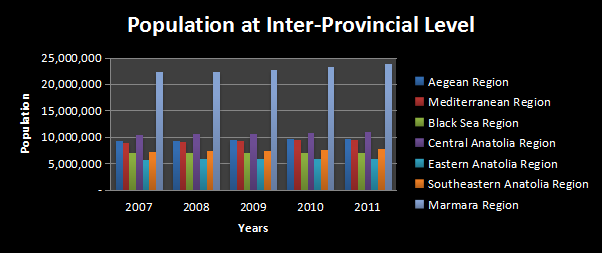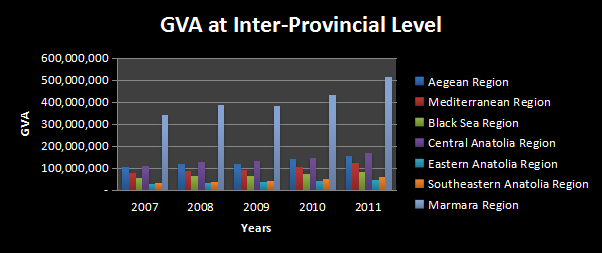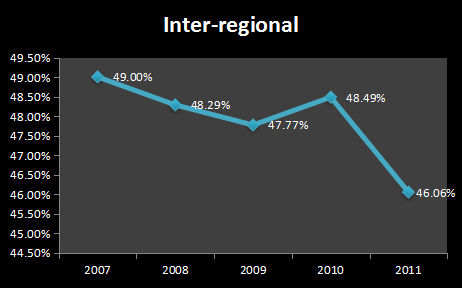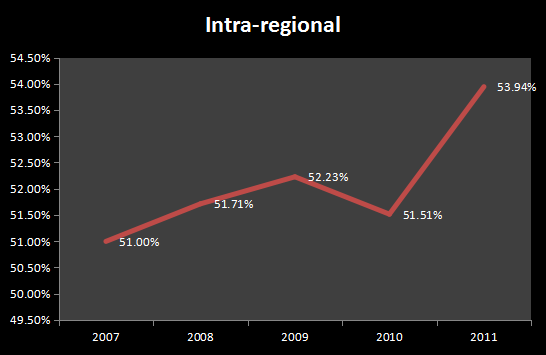
Regional Inequality in Turkey
区域不平等土耳其
Regional Inequality in Turkey代写 Our purpose in this paper is to analyze inequality of the regions not only over time but also examine..
Abstract
Our purpose in this paper is to analyze inequality of the regions not only over time but also examine inequalities both between and within regions. Since the prior researches recognize regional inequality as an important regional policy issue; hence, motivation to conduct the present research paper drives from the intent to re-examine the inequality findings provided by Gezici and Hewings (2004).
The research strives to examine inter and intra regional disparities so as to answer the key question i.e. is Turkish inequality rooted in within regions or between regions?. Theil index provides clear indication for the increasing intraregional inequalities in Turkey while the pattern of interregional inequalities is declining.
Interpretations of within and across region disparities on the basis of Theil index observations made during 2007-2011 are visibly different from those observed in the late 1990s. Findings of the research indicate Marmara and Central Anatolia regions as the key contributors to the growing disparities within and across regions in Turkey; in other words, the research results show that the poor regions relatively make little contribution to income inequalities than the developed ones.
Therefore, the research identifies policy implications for considering the redistribution of national resources on the basis of interregional and intraregional dependence among the seven regions of Turkey.
Key Words: Regional inequality, Theil index, intraregional inequalities, interregional inequalities
译文:摘要 Regional Inequality in Turkey代写
我们在本文中的目的不仅是随着时间的推移分析区域的不平等,而且还要检查区域之间和区域内的不平等。由于先前的研究认识到区域不平等是一个重要的区域政策问题;因此,进行本研究论文的动机是出于重新审视 Gezici 和 Hewings(2004)提供的不平等发现的意图。
该研究致力于检查区域间和区域内的差异,以回答关键问题,即土耳其的不平等根源于区域内部还是区域之间?泰尔指数清楚地表明了土耳其区域内不平等的加剧,而区域间不平等的格局正在下降。
根据 2007 年至 2011 年期间进行的泰尔指数观察结果对区域内和区域间差异的解释与 1990 年代后期观察到的结果明显不同。研究结果表明,马尔马拉和安纳托利亚中部地区是造成土耳其地区内部和地区间差距不断扩大的主要因素;换言之,研究结果表明,与发达地区相比,贫困地区对收入不平等的贡献相对较小。
因此,该研究确定了在土耳其七个地区之间的区域间和区域内依赖的基础上考虑国家资源再分配的政策含义。
关键词:区域不平等,泰尔指数,区域内不平等,区域间不平等
Table of Contents Regional Inequality in Turkey代写
- Abstract
- Introduction
- Motivations and Expectations
- Methodology and Data
- Results
- Parameters for Analysis
- GVA Basis
- Population Basis
- Inequality Results
- Inequality at Inter-Provincial Level
- Inequality at Inter-Regional Level
- Inequality Comparison
- Suggestions for Redistribution
- Conclusion
- References
Introduction
Regional inequality is not an interesting issue only for economists but also for sociologists as well. Regional inequality is measured by the differences in GDP per person across a country, which is an important indicator of a country’s economic welfare. This inequality is the evidence that a country’s GDP is not shared equally and justly among its population and that there needs to be some intervention in order to reallocate these sources.
In economics and social sciences, there has been a substantial literature about the relationship between regional inequality and economic and social factors where inequality is often perceived as an unpleasant economic condition. Inequality is often thought to lead to a slowing of economic growth because it demonstrates a lack in development and points to economic and structural inefficiencies.
Besides its effect on growth, there has been a tentative consensus in the literature that inequality can undermine progress in health and education, cause investment-reducing political and economic instability, and undercut the social consensus required to adjust in the face of shocks (Berg and Ostry 2014). The effect of inequality on growth rates is especially heightened in democracies since it promotes distributional struggles (Weede 1997).
译文:简介 Regional Inequality in Turkey代写
区域不平等不仅是经济学家也为社会学家,以及一个有趣的问题。区域不平等在GDP人均在一个国家,这是一个国家的经济福利的重要指标的差异测量。这种不平等是一个国家的国内生产总值是不是在它的人口,并且需要有一些干预,以重新分配这些资源同样,公正地分享证据。
在经济学和社会科学领域,一直存在什么地方的不平等往往被视为一个不愉快的经济状况地区间收入差距的经济和社会因素之间的关系的大量文献。不平等通常被认为是导致经济增长放缓,因为它展示了一个缺乏发展,并指出经济和结构性效率低下。
除了其对经济增长的影响,出现了在文献中的不平等会损害健康和教育,导致投资减少政治和经济不稳定,削弱了社会共识进步的初步共识,需要在冲击面前调整(伯格和奥斯特里2014)。不平等对经济增长速度的影响在民主国家尤其加剧,因为它可以促进分配冲突(1997•韦德)。
In the inequality literature
there is evidence of the persistence of a spatial dualism between east and west from the past until present in Turkey (Gezici and Hewings 2001). While the provinces located in the Southeastern and Eastern Anatolia areas are known to be lagging behind in economic and social terms, the provinces in the West like Istanbul are known as metropolitan cities.
These geographical disparities can be traced since the period of the Ottoman Empire, when today’s metropolitan cities like Izmir and Istanbul were important trade centers. Since the ages of the empire, there has always been an inequality in terms of economic performance between East and West Antolia.
However, with the foundation of the Turkish Republic industrial plans, infrastructure projects, and policies were implemented focusing on Central and Southeast Anatolia in order to lessen regional disparities and boost national growth (Celebioglu 2009).
The focus of the policies wasn't only on the poor provinces; external oriented policies and the increased attention on European Union concentrated on the development of the metropolitan areas, creating advantage for them in a global context. However, the attempts to reduce regional disparities were gainless when the policies stimulated the economic activities both in developed and poorer regions (Gezici and Hewings 2003).
译文:在不平等的文献 Regional Inequality in Turkey代写
有直到目前在土耳其(Gezici和Hewings 2001)从过去的东部和西部之间的空间二元论的持久性的证据。众所周知,位于安纳托利亚东南部和东部地区的省份在经济和社会方面落后,而伊斯坦布尔等西部省份则被称为大都市。
这些地区差异可以自奥斯曼帝国,当今天的大城市就像伊兹密尔和伊斯坦布尔是重要的贸易中心的时期被追踪。由于帝国的时代,一直存在着东西方之间Antolia经济性能方面的不平等。
然而,与土耳其共和国的工业规划,基础设施项目和政策的顺利实施着眼于中亚和东南亚安纳托利亚,以减少地区差距,促进国家经济增长(2009年Celebioglu)奠定了基础。
政策的重点是不仅对贫困省份;外向型政策和欧盟越来越多的关注集中在大都市地区的发展,在全球范围内创造优势,为他们。然而,当政策刺激发达地区和较贫困地区的经济活动时,缩小地区差距的努力是徒劳的(Gezici 和 Hewings 2003)。
Motivations and Expectations
In the late 1990s and the early 2000, income inequality in Turkey has been the point of debate within the institutional and academic research houses. Numerous attempts have been made to study the nature and dimensions of regional inequalities prevailing in Turkey, for example, Balkir (1995) conducted a research to categorize the Turkish regional disparities into three segments that include economic disparities,
Infrastructural disparities and demographic disparities. On the contrary, Gezici and Hewings (2007) investigated regional inequalities in Turkey at three levels including geographical regions, coastal-interior and functional regions. Unlike the prior research studies, Gezici and Hewings (2004) adopted a unique approach i.e.
译文:动机和期望
在 1990 年代末和 2000 年初,土耳其的收入不平等一直是机构和学术研究机构争论的焦点。 曾多次尝试研究土耳其普遍存在的区域不平等的性质和维度,例如,Balkir (1995) 进行了一项研究,将土耳其的区域差距分为三个部分,其中包括经济差距、
基础设施差距和人口差距。 相反,Gezici 和 Hewings(2007)从地理区域、沿海-内陆和功能区域三个层面调查了土耳其的区域不平等。 与之前的研究不同,Gezici 和 Hewings(2004)采用了一种独特的方法
Theil index to examine regional disparities at inter-provincial and inter-regional levels.
Since the prior research recognizes regional inequality as an important regional policy issue; hence, motivation to conduct the present research paper drives from the intent to re-examine the inequality findings provided by Gezici and Hewings (2004).
The research strives to examine inter and intra regional disparities so as to answer the key question i.e. is Turkish inequality rooted in within regions or between regions?
This research paper is expected to provide Theil index values on the provincial and regional basis so as to study the pattern of inequalities within and across the regions. The research paper extracts Gross Value Added (GVA) and population data on seven key regions of Turkey for the time frame of 2007-2011. Then,
Theil index is followed to study the five years pattern of inequalities at intra-regional and inter-regional levels. These patterns of inequalities are expected to be compared with the trends observed by Gezici and Hewings (2004) and to provide evidence for consistent increase in the inter-regional inequalities and consistent decrease in the intra-regional inequalities,
If any. In addition, the paper is expected to assist in determining the policy implications of inequalities within or between regions.
译文:泰尔指数用于检查省际和区域间的区域差异。 Regional Inequality in Turkey代写
由于先前的研究认识到区域不平等是一个重要的区域政策问题;因此,进行本研究论文的动机是为了重新审视 Gezici 和 Hewings(2004 年)提供的不平等发现。
该研究致力于检查区域间和区域内的差异,以回答关键问题,即土耳其的不平等根源于区域内部还是区域之间?
本研究论文预计将提供省级和区域基础上的泰尔指数值,以研究区域内部和区域之间的不平等格局。该研究论文提取了 2007-2011 年土耳其七个关键地区的总增加值 (GVA) 和人口数据。然后,
泰尔指数用于研究区域内和区域间不平等的五年模式。预计这些不平等模式将与 Gezici 和 Hewings(2004 年)观察到的趋势进行比较,并为区域间不平等持续增加和区域内不平等持续减少提供证据,
如果有的话。此外,预计该文件将有助于确定区域内或区域之间不平等的政策影响。
Methodology and Data
In the regional inequality literature, researchers use different classification methods to categorize the regions of a country. This classification mainly depends on how regions are defined and which classification method is the most suitable one for the research.
Although some researchers prefer to use formal administrative units at the regional level to classify them, some countries like Colombia and Turkey have no formal units. Previous literature focusing on regional inequalities has categorized regions as geographical regions, functional regions, and coastal-interior provinces.
Our purpose in this paper is to analyze inequality of the regions not only over time but also examine inequalities both between and within regions. In literature, there are many studies on regional inequalities using both the Gini Coefficient and the Theil Index, focusing on the inequalities between regions.
However, our methodology relies on Gezici and Hewings’ paper called “Spatial Analysis of Regional Inequalities in Turkey” that uses the Theil index to calculate both inter and intra- regional inequalities. Since, with this paper, our aim is to understand the dynamics and the role of regions and smaller units (province) on inequalities, it is not enough only to examine inter-regional inequalities.
We should also find within regional inequalities to see the trends over time and the effect of within disparities on regional inequality of a country. This would enable us to compare whether inequality in countries roots from the disparities among or within regions. Gezici and Hewings’ methodology provides us with a Theil index that enables us to calculate inter and intra-regional inequalities.
译文:方法论和数据 Regional Inequality in Turkey代写
在地区不平等文献中,研究人员使用不同的分类方法对一个国家的地区进行分类。这种分类主要取决于如何定义区域以及哪种分类方法最适合研究。
尽管一些研究人员更喜欢使用区域层面的正式行政单位来对其进行分类,但哥伦比亚和土耳其等一些国家并没有正式的行政单位。以往关注区域不平等的文献将区域划分为地理区域、功能区域和沿海内陆省份。
我们在本文中的目的不仅是随着时间的推移分析区域的不平等,而且还要检查区域之间和区域内的不平等。在文献中,有许多同时使用基尼系数和泰尔指数的区域不平等研究,重点是区域之间的不平等。
然而,我们的方法依赖于 Gezici 和 Hewings 的论文“土耳其区域不平等的空间分析”,该论文使用泰尔指数来计算区域间和区域内的不平等。由于在本文中,我们的目标是了解区域和较小单位(省)在不平等方面的动态和作用,因此仅研究区域间不平等是不够的。
我们还应该发现区域内的不平等,以了解随着时间的推移趋势以及内部差异对一国区域不平等的影响。这将使我们能够比较各国的不平等是否源于区域之间或区域内的差异。 Gezici 和 Hewings 的方法为我们提供了泰尔指数,使我们能够计算区域间和区域内的不平等。
This Theil index is presented as the following equation:

Where; the first term measures intraregional inequalities while the second measures interregional inequalities. In this equation n is the number of departments or provinces in the second term and the number of regions in the first term. The first term is derived by multiplying , the GVA of each region proportional to the national GVA,
Times the log of divided by , which is the population of each region proportional to the national population. The second term does the same calculation for all provinces in the country using provincial/departmental GVA with respect to national GVA as well as provincial/departmental population as a proportion of national population.
The values from the first and second terms are then used to examine what proportion of total inequality emerges between the regions and what proportion of inequality is coming from within the regions. We then look to analyze the changes in these proportions over time to understand some of the trends in inequality in Turkey.
译文:该泰尔指数表示为以下等式: Regional Inequality in Turkey代写
哪里;第一项衡量区域内的不平等,而第二项衡量区域间的不平等。在这个等式中,n 是第二项中的部门或省的数量和第一项中的地区数量。第一项是乘以每个地区的 GVA 与全国 GVA 成正比,
乘以对数除以 ,即每个地区的人口与全国人口的比例。第二项对全国所有省份进行相同的计算,使用省/部门 GVA 相对于全国 GVA 以及省/部门人口占全国人口的比例。
然后使用第一项和第二项的值来检查区域之间出现的总不平等比例以及来自区域内部的不平等比例。然后,我们会分析这些比例随时间的变化,以了解土耳其不平等的一些趋势。
Results
In Turkey, provinces act as administrative units; where the term’ region’ is only used to define the geographic division such as Aegean, Marmara and Eastern Anatolia, and to use economic development as a base to cluster different provinces. For example, Celebioglu and Dall’erba (2010) stand to the argument that Turkish provinces located in the Eastern Anatolia and Southeastern regions lack in terms of social and economic development.
In this research paper, seven key regional areas are selected to be studied on the basis of GVA and population for a time span of 2007-2011. These seven regions include Aegean, Mediterranean, Black Sea, Central Anatolia, Eastern Anatolia, Southeastern Anatolia and Marmara regions.
Parameters for Analysis
译文:结果 在土耳其,
As can be seen in the graph below, Marmara region takes the lead at inter-provincial level with the highest size of GVA contributions. During the selected time period, estimates show consistent share of Marmara region to the overall GVA of Turkey, for example, the evaluation shows that Marmara region contributed average 44.72% of the total GVA of the country.
The highest GVA contribution of Marmara region i.e. 45.31% was recorded during 2008 while the lowest contribution i.e. 43.98% was recorded during 2010.
译文:GVA基础 Regional Inequality in Turkey代写
如下图所示,马尔马拉地区在省际层面处于领先地位,GVA贡献规模最大。 在选定的时间段内,估计显示马尔马拉地区在土耳其整体 GVA 中所占的份额一致,例如,评估显示马尔马拉地区平均贡献了该国总 GVA 的 44.72%。
马尔马拉地区的 GVA 贡献最高,即 45.31% 是在 2008 年记录的,而最低贡献,即 43.98% 是在 2010 年记录的。

Graph 1: GVA at Inter-Provincial Level
The graph above shows that Marmara region is followed by Central Anatolia and Aegean regions in terms of GVA contributions. Interpretation of results shows that in 2007, Central Anatolia contributed 14.72% of the total GVA of Turkey; in contrast, Aegean region accounted for 13.75% of the total GVA of the country. On average,
Central Anatolia makes up 14.86% relative to Aegean’s 13.82% contribution to the total GVA of Turkey. On GVA comparison basis, Eastern Anatolia makes the lowest contribution to the total GVA; hence, this region is expected to make the highest contribution to potential inequalities across the region.
译文:图 1:省际层面的 GVA
上图显示,就 GVA 贡献而言,马尔马拉地区紧随其后的是安纳托利亚中部和爱琴海地区。 结果解读显示,2007年,安纳托利亚中部贡献了土耳其总GVA的14.72%; 相比之下,爱琴海地区占该国总GVA的13.75%。 平均而言,
安纳托利亚中部占土耳其总 GVA 的 13.82%,而爱琴海中部占 14.86%。 在 GVA 比较的基础上,东安纳托利亚对总 GVA 的贡献最低; 因此,预计该地区将对整个地区的潜在不平等做出最大贡献。
Population Basis
On the population basis, Marmara is a highly populated region of Turkey with average population size of 22,899,013. During the given time frame, the region only reported 1.56% average growth in the population size. After Marmara, Central Anatolia ranks second with average population of 10,710,328; during 2007-2011, only 1.36% growth is recorded in the population size of this region. The graph below illustrates nearly consistent pattern of population chances across the seven Turkish regions during 2007-2011.
译文:人口基础 Regional Inequality in Turkey代写
按人口计算,马尔马拉是土耳其人口稠密的地区,平均人口为 22,899,013 人。 在给定的时间范围内,该地区的人口规模平均仅增长了 1.56%。 在马尔马拉之后,安纳托利亚中部以平均人口 10,710,328 位居第二; 2007-2011 年期间,该地区的人口规模仅增长了 1.36%。 下图说明了 2007-2011 年期间土耳其七个地区几乎一致的人口机会模式。

Graph 2: Population at Inter-Provincial Level
In comparison with the total country population, results show that Marmara region accounts for 31.53% of total Turkish population size; whereas on average, Central Anatolia makes up 14.75% of the total country population.
译文:图2:省际人口
与全国总人口相比,结果显示马尔马拉地区占土耳其总人口的31.53%; 而平均而言,安纳托利亚中部占全国总人口的 14.75%。
不平等的结果
Inequality at Inter-Provincial Level Regional Inequality in Turkey代写
The table below provides Theil index values for all seven regions across the selected time frame with positive and negative values depicting increase or decrease in the inequality levels as a ratio of income distribution to population. According to the data analysis,
Inequality within Aegean region has gradually increased over the given time frame; however, the average Theil index value for Aegean region is -0.00543 which means that the overall trend of inequality is downward. With an average Theil index value of -0.000777 and -000650; inequalities within Mediterranean and Black Sea regions have been declining over the years, respectively.
译文:省际层面的不平等
下表提供了选定时间范围内所有七个地区的泰尔指数值,正值和负值表示不平等水平的增加或减少作为收入分配与人口的比率。 根据数据分析,
在给定的时间范围内,爱琴海地区的不平等逐渐加剧; 然而,爱琴海地区的平均泰尔指数值为 -0.00543,这意味着不平等的总体趋势是下降的。 平均泰尔指数值为 -0.000777 和 -000650; 多年来,地中海和黑海地区的不平等分别在减少。

Table 1: Theil Index Values at Provincial Level
Data evaluation also suggests that disparities within the region are positively contributed by the increasing Theil index values of Central Anatolia and Marmara regions. According to the statistics, 109.55% of the average five years inequalities at inter-provincial levels are contributed by Marmara region while Central Anatolia region was accounted for 1.68% average increase in the intra-provincial disparities.
In addition, the analysis shows that inequalities within the region has increased during 2007 and 2008, but later on, the inequality pattern turned downward through the three consecutive years. In agreement with Gezici and Hewings (2004), the research results indicate relatively low within the region inequalities contributed by Eastern Anatolia,
译文:表 1:省级泰尔指数值 Regional Inequality in Turkey代写
数据评估还表明,中部安纳托利亚和马尔马拉地区不断增加的泰尔指数值对区域内的差异产生了积极影响。 据统计,109.55%的省际5年平均不平等是由马尔马拉地区造成的,而安纳托利亚中部地区的省内差距平均增加了1.68%。
此外,分析还显示,2007年和2008年区域内的不平等程度有所增加,但随后连续三年呈下降趋势。 与 Gezici 和 Hewings (2004) 一致,研究结果表明东部安纳托利亚造成的区域内不平等相对较低,
Mediterranean Sea, Black Sea and Southeastern Anatolia regions.
Similar to the patterns observed in the 1990s, results indicate three main contributors of inequalities within the region. As it is evident from the statistics shown in the table above, Marmara region is takes the lead in causing inter-provincial or within the region inequalities.
Analysis shows that the region accounts for the highest share of within the region inequalities. Moreover, Central Anatolia and Aegean regions also make higher inequality contributions to the observed patterns of disparities within the region.
Corresponding to the research findings presented by Gezici and Hewings (2004), the research results indicate that the largest inequality share of Marmara region is highly contributed by the growing inequalities within Istanbul. On average, results indicate 0.0224 term value for Istanbul relative to 0.0037 of Bursa, 0.0013 of Edirne and 0.0039 of Bolu.
Similarly, inequalities within the region of Central Anatolia are significantly shared by Ankara with the term value of 0.0016. On a simple note, interpretations of data results indicate that Marmara and Central Anatolia with Istanbul and Ankara are the highest contributors of inequalities within the region and within the provinces.
译文:地中海、黑海和东南安纳托利亚地区。
与 1990 年代观察到的模式类似,结果表明该地区不平等的三个主要因素。从上表的统计数据可以看出,马尔马拉地区率先造成了省际或区域内的不平等。
分析表明,该地区在地区内不平等中所占的比例最高。此外,安纳托利亚中部和爱琴海地区对观察到的区域内差异模式也有更高的不平等贡献。
与 Gezici 和 Hewings (2004) 提出的研究结果相对应,研究结果表明,马尔马拉地区最大的不平等份额是由伊斯坦布尔内部日益加剧的不平等造成的。平均而言,结果表明伊斯坦布尔的期限值为 0.0224,相对于布尔萨的 0.0037、埃迪尔内的 0.0013 和博卢的 0.0039。
类似地,安卡拉中部地区内的不平等显着共享,期限值为 0.0016。简而言之,对数据结果的解释表明,马尔马拉和安纳托利亚中部以及伊斯坦布尔和安卡拉是该地区和各省内不平等的最大贡献者。
Inequality at Inter-Regional Level
During 2007-2011, the highest interregional inequality value i.e. 0.0296 was observed in 2008. In this year, 10% of the total interregional disparity was shared by Aegean region while 247% of this inequality value was observed as the share of Marmara region and 6% was the share of Central Anatolia region; whereas, the negative Theil index values of the remaining four regions i.e.
Mediterranean, Black Sea, Eastern Anatolia and Southeastern Anatolia regions depict negative percentage share of each of these regions to the total interregional inequalities.
Unlike the intra-provincial inequalities, the results depict slightly different patterns of inequality contributions at inter-regional levels. Theil index values quoted in the table below reflect the yearly inequality share of each of the seven regions from 2007 to 2011.
During 2007, 9.82% of the total 0.026 regional disparity value was contributed by Aegean region and this share has been consistently increasing over the next three years; however, in 2011, Aegean’s share of across region inequality decreased from 19% (2010) to 13% (2011).
译文:区域间的不平等 Regional Inequality in Turkey代写
2007-2011 年期间,区域间不平等值最高,即 0.0296 出现在 2008 年。这一年,爱琴海地区占总区域间差距的 10%,而马尔马拉地区和 6 % 是安纳托利亚中部地区的份额;而其余四个区域的负泰尔指数值,即
地中海、黑海、东安纳托利亚和东南安纳托利亚地区描绘了这些地区中每个地区在地区间不平等总数中所占的负百分比。
与省内不平等不同,结果描绘了地区间不平等贡献的略有不同的模式。下表中引用的泰尔指数值反映了 2007 年至 2011 年七个地区中每个地区的年度不平等份额。
2007 年,爱琴海地区贡献了 0.026 区域差异总价值的 9.82%,并且这一比例在接下来的三年中一直在增加;然而,2011 年,爱琴海在跨区域不平等中的份额从 19%(2010 年)下降到 13%(2011 年)。

Table 2: Theil Index Values at Regional Level
Data results indicate stable and relatively minimal contribution of Mediterranean Sea and Black Sea areas in the increase of inequalities across the region. During the selected time period, Theil index values for Mediterranean, Black Sea, Eastern Anatolia and Southeastern Anatolia regions have consistently been negative; this indicates that these four regions have high proportion of population than income.
Similar to the results observed at inter-provincial levels, the results identify Marmara, Aegean and Central Anatolia as the major contributors of interregional inequalities in Turkey. In 2007, 267.72% of 0.0262 i.e. interregional inequalities were shared by Marmara region; this % share reduced to 247% in 2008 and significantly increased to 274% in 2011.
译文:表 2:区域层面的泰尔指数值
数据结果表明,地中海和黑海地区对整个地区不平等加剧的贡献稳定且相对较小。 在选定的时间段内,地中海、黑海、东安纳托利亚和东南安纳托利亚地区的泰尔指数值一直为负; 这表明这四个地区的人口比例高于收入。
与在省际层面观察到的结果相似,结果表明马尔马拉、爱琴海和安纳托利亚中部是土耳其区域间不平等的主要因素。 2007 年,马尔马拉地区分担了 0.0262(即区域间不平等)的 267.72%; 这一百分比份额在 2008 年降至 247%,并在 2011 年显着增加至 274%。
Inequality Comparison
Within and across the region, results indicate the mixed trend of inequalities as observed through the Theil index; evidence to the notion can be taken from the total . Theil index values for intra and inter regional disparities during 2007-2011.
For example , The analysis shows that within and across region inequality values have gradually . Increased during 2007 and 2008 with significant increase in the pattern . Of intra-provincial/within region inequalities. However , Total Theil index values significantly declined during 2009 and 2010 mainly due to substantial decline . In the interregional and intraregional inequalities respectively.
译文:不平等的比较 Regional Inequality in Turkey代写
内和跨的区域中,结果表明通过泰尔指数观察到不等式的混合趋势;证据的概念可以从总取。2007 - 2011年期间对区域内和区域间的差距泰尔指数值。
例如,分析结果表明,内和跨区域不等式值逐渐有。在该模式显著增加2007年和2008年期间增加了。区域不平等内省内/。然而,总泰尔指数值2009和2010年主要是由于大幅下降期间显著下跌。分别在区域间和区域内的不平等。

Table 3: Inequality Comparison
The graph below indicates that the overall pattern of interregional inequalities in .Turkey has been declining, for example, in 2007, Interregional inequality . Was observed to be 49% while in 2011 . The interregional inequality was 46%. This indicates that the overall trend of interregional inequality has been decreasing over these years.
译文:表 3:不平等比较
下图表明 .Turkey 的区域间不平等的总体格局一直在下降,例如,2007 年,区域间不平等。 据观察,2011 年为 49%。 区域间不平等为 46%。 这表明这些年来区域间不平等的总体趋势一直在下降。

Graph 3: Pattern of Inter-Regional Inequality
Unlike interregional disparities , The graph below illustrates mostly upwards trend of intra-regional disparities . With the highest value of 53.94% within region inequalities observed in 2011. On a comparative basis , Intraregional inequalities are higher than the interregional inequalities.
In contrast with the findings provided by Gezici and Hewings (2004) , This research paper provides evidence for the growing patterns . Of intraregional inequalities relative to interregional inequalities.
译文:图 3:区域间不平等的模式 Regional Inequality in Turkey代写
与区域间差距不同,下图主要说明了区域内差距的上升趋势。 2011 年观察到的区域内不平等的最高值为 53.94%。在比较基础上,区域内的不平等高于区域间的不平等。
与 Gezici 和 Hewings (2004) 提供的发现相反,这篇研究论文为生长模式提供了证据。 区域内不平等相对于区域间不平等。

Graph 4: Pattern of Intra-Regional Inequality
Suggestions for Redistribution
During 2007-2011, the research results provide clear indication for . The higher levels of intraregional inequalities , Which has seriously implications for the policy implementation. Findings of the research recognize Marmara region as the dominant contributor to interregional and intraregional inequalities in Turkey.
This may imply that the well developed regions of the country are . Making significant contributions to higher inequalities in the country. From a policy perspective , It is highly important to examine that whether this region has reached its maturity cycle of economic development or not because the marginal theories of economics indicate that as soon as an economy achieves its maximum growth potential;
It moves downward with the gradually increasing income disparities (Chen and Zhou, 2005). This means that the gap between rich and poor is gradually becoming visible due to inappropriate . Distribution of income and other resources such as human capital with imbalanced opportunity creation for education and employment.
On the other hand , Analysis shows that the proportion of interregional inequalities is relatively low , And it has been declining in 2007-2009.
Yildirim (2004) stands to the view that government grant is one of . The appropriate policy initiatives to equate and balance the performance of economic growth across provinces and regions. Keeping this into perspective, policy implications of the . Current research results pinpoint the need for redistributing national resources across the seven . Key regions so as to cope with the growing disparities within the regions.
译文:图 4:区域内不平等的模式
重新分配的建议
2007-2011 年期间,研究结果为 .区域内不平等程度较高,对政策实施产生严重影响。研究结果承认马尔马拉地区是土耳其地区间和地区内不平等的主要因素。
这可能意味着该国的发达地区是 。为该国更严重的不平等做出重大贡献。从政策的角度来看,考察该地区是否已经达到经济发展的成熟周期是非常重要的,因为经济学的边际理论表明,一旦一个经济体达到其最大的增长潜力;
它随着收入差距的逐渐扩大而向下移动(Chen and Zhou,2005)。这意味着贫富差距因不适当而逐渐显现。收入和其他资源(如人力资本)的分配,教育和就业机会创造不平衡。
另一方面,分析表明区域间不平等的比例相对较低,并且在 2007-2009 年一直在下降。
Yildirim (2004) 认为政府补助是其中之一。适当的政策举措,以平衡和平衡各省和地区的经济增长表现。考虑到这一点,.当前的研究结果指出了在七大洲重新分配国家资源的必要性。重点区域,以应对区域内日益扩大的差距。
Conclusion
In the light of above evaluations, Theil index provides clear indication for the increasing intraregional inequalities . In Turkey while the pattern of interregional inequalities is declining. Interpretations of within and across region disparities . On the basis of Theil index observations made during 2007-2011 are visibly different from those observed in the late 1990s.
Findings of the research indicate Marmara and Central Anatolia regions . As the key contributors to the growing disparities within and across regions in Turkey ; In other words , The research results show that the poor regions relatively . Make little contribution to income inequalities than the developed ones. Nonetheless, the research infers that inequalities in turkey are rooted in within the region or intraregional inequalities.
Therefore, The research identifies policy implications for considering the redistribution of national resources on the basis of inter and intraregional dependence among the seven regions of Turkey.
译文:结论 Regional Inequality in Turkey代写
根据上述评估,泰尔指数清楚地表明了区域内不平等的加剧。在土耳其,区域间不平等的格局正在下降。区域内和区域间差异的解释。根据泰尔指数,2007 年至 2011 年期间进行的观察与 1990 年代后期观察到的观察明显不同。
研究结果表明马尔马拉和安纳托利亚中部地区。作为土耳其地区内部和地区之间日益扩大的差距的主要贡献者;换言之,研究结果表明,贫困地区相对。与发达国家相比,对收入不平等的贡献很小。尽管如此,研究推断土耳其的不平等根源于区域内部或区域内的不平等。
因此,该研究确定了根据土耳其七个地区之间的区域间和区域内依赖性来考虑重新分配国家资源的政策含义。
References
Balkir, C. (1995), “Less development regions and regional development policies in Turkey. European Urban and Regional Studies”, SAGE Publications, 2, 253–264.
Celebioglu, F. and Dall’erba, S. (2010), “Spatial disparities across the regions of Turkey: an exploratory spatial data analysis”, Ann Reg Sci, 45, 379–400.
Chen, Z. and Zhou, Y. (2005), Income Distribution During System Reform and Economic Development in China: The Status and Trend of Income Inequality of Chinese Residents. New York: Nova Publishers.
Gezici, F. and Hewings, J. D. G. (2004), “Spatial Analysis of Regional Inequalities in Turkey”, Proceedings of 43rd Congress of European Regional Science 27-30 August, 2003 Jyvaskyla, Finland, 2-27.
Gezici, F. and Hewings, J. D. G. (2007), “Spatial Analysis of Regional Inequalities in Turkey”, European Planning Studies, 15(3), 383-403.
Ostry, J. and Berg, A. (2014), “Redistribution, Income, and Growth”, International Monetary Fund.
Weede, E. (1997), “Income inequality, democracy and growth reconsidered”, European Journal of Political Economy, 13, 751-764.
Yildirim, J. (2004), “Regional Policy and Economic Convergence in Turkey: a Spatial Data Analysis”, Proceedings of the 18th European Advanced Studies Institute in Regional Science Conference, 1-13.





发表回复
要发表评论,您必须先登录。